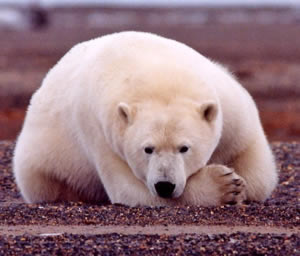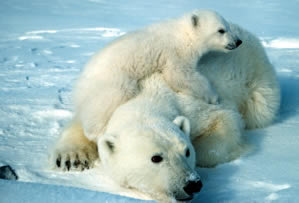
 |
Climate change skeptics roll onApril 9, 2007Courtesy of Far North Science 
Hurricane Katrina Credit: NOAA NEWS Is protecting polar bears in the face of fast-shrinking sea ice some wonky blunder that will throw people out of work and take down Alaska's economy? When hundreds of scientists produce a report that blames global warming largely on human greenhouse emissions, should they be whapped upside the head with their pocket protectors for overreaching the data? Just ask climate-warming skeptic William Gray, a top hurricane forecaster. Or perhaps you could consult that August (if not soggy) body of climate experts from rainy Juneau - the Alaska Legislature. It has recently passed resolutions urging the U.S. Fish and Wildlife Service that polar bears are doing fine and don't need coddling by the federal government. With the drumbeat of climate warming consensus lending momentum to the notion that people must reduce carbon emissions, the voices that cry foul get even more play in the media. HURRICANES ARE JUST HOT AIRBlame the recent batch of mondo hurricanes on ocean currents and not some global warming juggernaut, says hurricane forecaster William Gray this week, in a speech to the National Hurricane Conference that has been reported all over the Internet. "I think the whole human-induced greenhouse gas thing is a red herring," Gray said, according to a story by Reuters. Gray, whose annual forecasts for the hurricane season are closely watched, said the Earth has warmed the past 30 years, but that it was due to fluctuations in ocean currents. He predicted a cooling off period would begin in five to 10 years as the currents change again. But Gray himself has been the subject of some withering criticism from climate scientists. It's worth checking out this 2006 post on RealClimate. In Gray and Muddy Thinking about Global Warming, the RealClimate dudes say Gray's interpretations are littered with "fundamental misconceptions on the physics of climate" that would shrivel if scrutinized by peer review. For years, perhaps decades, Gray has been ascribing all sorts of climate changes and hurricane cycles to fluctuations in the Thermohaline Circulation (THC), an overturning circulation in the Atlantic ocean associated with formation of deep water in the North Atlantic. POLAR BEARS DON'T NEED NO STINKIN' PROTECTION
USFWS photo Climate scientists say the Arctic could become free of sea ice during summers within a generation. That would eliminate almost all of the habitat used by polar bears for denning and foraging. In areas with reduced sea ice cover - like Hudson Bay - polar bear populations have already seen dramatic declines in number and health. Even in Alaska, with sea ice reductions still far less dramatic than Hudson Bay, scientists have recorded changes in behavior and migration. Bears have drowned and eaten each other, and been found starving. Add that data, mix it with a suit from environmental groups, and the U.S. Fish and Wildlife Service has proposed listing the bears as threatened under the Endangered Species Act. The deadline for public comments is Monday, April 9. 
USFWS - Scott Schliebe photo The Alaska Senate and House of Representatives have both passed resolutions opposing the added protections, and several have shrugged off current global warming thinking as so much blooey. House John Harris, R-Valdez, was quoted by the Anchorage Daily News as dismissing greenhouse gas emissions as some "unfounded, unproven scientific hypothesis" for explaining climate change. The polar bear proposal is a sinister ploy used by environmental groups in a "bigger darker agenda," according to House Resources committee co-chair Rep. Craig Johnson, R-Anchorage. These resolutions buttress a position taken by Alaska Gov. Sarah Palin in December. "When a species' habitat (in this case, sea ice) is declining due to climate change, but there are no discrete human activities that can be regulated or modified to effect change, what do you do?" she wrote to the USFWS. "We know listing polar bears as threatened will not impact polar bear numbers or cause sea water to freeze," Palin said. Where to begin? Gov. Sarah, whose husband is a champion snow machine racer, should try out the Carbon Calculator at Alaska Conservation Solutions to see how many tons of CO2 she and her family's "discrete human activities" produce each year. (It was startling for me to review my own production.) Meanwhile, Alaska's latterday Solons should review the Intergovernmental Panel on Climate Change summary for policy makers published in February. Though widely criticized as watered-down and possibly understating the danger, the summary still calls evidence of climate warming "unequivocal," with human greenhouse gas emissions "very likely" the main cause. It's hard to ignore CO2 levels at their highest concentrations in 650,000 years. Or simply throw out a consensus statement reviewed by 600 scientists, then approved by 300 delegates from 130 countries. On the polar bear issue, Alaska's officials may be confusing wishes with horses. They should actually read the Endangered Species Act and the USFWS polar bear website. The question of whether an animal deserves heightened protection depends on biology. It never hinges on whether it hinders Alaska oil development or makes immediate sense to people wearing suits. Among other reasons, the federal government is required by law to list a species as threatened if it faces "present or threatened destruction, modification or curtailment of its habitat or range." Recent research by scientists at the National Snow and Ice Data Center suggests that summer sea ice will all-but disappear from the Arctic Ocean within two or three polar bear generations. Sounds pretty clearly like "threatened destruction" of polar bear habitat. |
|